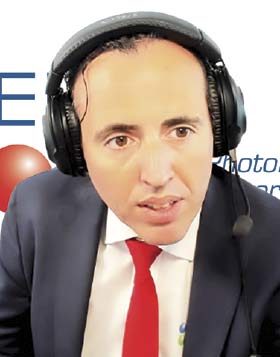JOSE POZO, EUROPEAN PHOTONICS INDUSTRY CONSORTIUM
A significant problem for innovators of medical devices is how long new designs take to reach production and get into the hands of the consumers who can use them. This dilemma has become glaringly obvious as America, Europe, and the rest of the world has grappled with a disrupted supply chain during the COVID-19 pandemic.
Governmental regulation is part of the problem, requiring multiple layers of testing and approval. In both the U.S. and Europe, the groundwork must be laid to get products to clinical trial much more quickly.
But the photonics industry in the biomedical space can also be territorial. Only a handful of large manufacturers of medical devices are capable of mass-producing them, and it is very difficult to get these manufacturers to provide a list of requirements for components. So, innovators are left to design the devices on their own, when, in any other segment of the economy, such as agriculture, it’s possible to go right to a systems integrator for specifications.
Unfortunately, there is generally no real communication between device manufacturers and other segments of the supply chain. Developing a new device can be extremely expensive, and even if it gets validated, it can’t always be sold. Investors may be reluctant at first, and therefore — for all these reasons — it can take 10 years to bring a device to market.
If anything positive has come out of
the COVID-19 pandemic, it’s the way
academics, engineers, product
developers, and governmental officials have come together to devise
innovative solutions to challenges
ranging from streamlining regulatory review to freeing up bottlenecks
in the manufacturing of portable,
point-of-care technologies.
So at EPIC (the European Photonics Industry Consortium), we always start out by asking biomedical device developers, “What suppliers are you working with?” Often, they have no answer to the question.
But the cooperation seen in the pharmaceutical industry as it has worked toward developing vaccines reveals what is possible when companies and government work together.
In the U.S., the National Institute of Biomedical Imaging and Bioengineering oversaw the Rapid Acceleration of Diagnostics initiative — a collaboration among many research institutions, corporate partners, and governmental agencies — for which government agencies spent hundreds of millions to expand diagnostic capacity through developers and manufacturers last year. Many of the diagnostic tests were intended to be performed in the clinic, at the point of care, or in the home.
At EPIC, we have a specialist in each sector of the photonics industry — for example, Elena Beletkaia, EPIC’s project leader, is our medical expert. These specialists help to build partnerships between sectors of the economy. Through our R&D centers, we work with companies to establish them in the supply chain. When we talk to the developers, they want to talk to doctors, and so we run an event that focuses on a different hospital each year. Doctors will share what technologies they could use, and photonics companies will try to meet the doctors’ needs in their research.
The European Commission puts a lot of money into medical devices, but developers need access to the core technologies. For this access to happen, the larger companies should
ideally be running an incubator program that would spur innovation.
If anything positive has come out of the COVID-19 pandemic, it’s the way academics, engineers, product developers, and governmental officials have come together to devise innovative solutions to challenges ranging from streamlining regulatory review to freeing up bottlenecks in the manufacturing of portable, point-of-care technologies. Now we know what’s possible. It’s time for the biomedical optics community to use this knowledge as a guide to address the urgent needs of the future.
Meet the author
 Jose Pozo, Ph.D., is director of technology and innovation at the European Photonics Industry Consortium (EPIC). As EPIC’s CTO, he represents more than 700 companies that are active in the field of photonics. His job consists of engaging with them and providing tools to strengthen their positions in the supply chain. Such tools include the organization of 25 technology workshops per year, provision of market intelligence, and finding B2B leads. Pozo holds a doctorate in electrical engineering from the University of Bristol in England and an M.Sc. and a B.Eng. in telecom engineering from Universidad Pública de Navarra in Spain and Vrije Universiteit Brussel in Belgium.
Jose Pozo, Ph.D., is director of technology and innovation at the European Photonics Industry Consortium (EPIC). As EPIC’s CTO, he represents more than 700 companies that are active in the field of photonics. His job consists of engaging with them and providing tools to strengthen their positions in the supply chain. Such tools include the organization of 25 technology workshops per year, provision of market intelligence, and finding B2B leads. Pozo holds a doctorate in electrical engineering from the University of Bristol in England and an M.Sc. and a B.Eng. in telecom engineering from Universidad Pública de Navarra in Spain and Vrije Universiteit Brussel in Belgium.
The views expressed in “Biopinion” are solely those of the author and do not necessarily represent those of Photonics Media. To submit a Biopinion, send a few sentences outlining the proposed topic to [email protected]. Accepted submissions will be reviewed and edited for clarity, accuracy, length, and conformity to Photonics Media style.